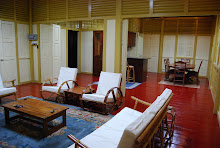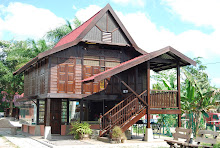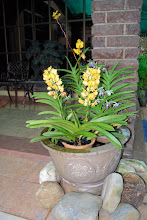It is therefore a sight to behold whenever we come across homes that inherit such characteristics. Not many are left standing and those that do deserve our attention; in whatever way.

While in a town in south Kedah, we came across this house by the main road. One would pass by it everyday but would never stop to give a glimpse thinking it is just another wooden house. Without fresh colorful paint work and instead darken by years of oily smeared timber frame it continues to escape attention. Yet at closer look, you would not mind calling it your own home, if the owner dares to part with it. That would be the last straw of course. It is a family home and certainly vibrates with life during Aidil Fitri or days when the whole family comes home.
Like typical Malay traditional home designed to suit the tropical climate, we would certainly notice directions at providing excellent ventilation throughout the home. This upstairs living room for example, ornately crafted from the outside, has wide windows even with louvers. Their upper sections are covered with panels with motifs of varied design. These air holes so craftily designed mesmerized us yet effectively they provide total air distribution throughout the house.
Looking closely, we see the white painted frame built up half-way at the opened window. While providing safety, it also allows inflow of fresh air when the windows are opened wide.

Taking a closer look around the house, we saw more floral or motif designs that are placed at strategic sections of the house. The facial-board fringing the whole house added to the beauty and pain staking care the original owner and craftsmen or ‘tukang rumah’ had taken in earlier time.

This is the house with the recent added section underneath. Though the owner gets more living space, he has indirectly halted good ventilation. Notice also the front staircase has ‘five’ steps (anak tangga). We would never counts steps with even numbers.

Nevertheless it has a characteristic of its own and we are banging on having it rebuilt and renovated. Wait until it is relocated and rebuilt. Hopefully we can show the picture again with its old splendor and in a better location. We found this house at Alor Janggus near Alor Star Kedah.
In an earlier story I have described how such homes have been sought after, relocated and built again to become ‘home stays’ much sought by foreigners as well as discerning visitors who want to feel the nostalgia of the past. Contact me later. We may help you discover that theme.

An Old Malacca House at FRIM Kepong Selangor.
A return visit to FRIM (Forest Research Institute Malaysia at Kepong Selangor) recently, led us to discover two old buildings on the site. One was a Malacca home known to have been built as early as 1917 which make it almost a century old now. The other is a Trengganu House just as ancient as the other. It is to be noted that many institutions have embarked on adopting old homes and rightly helped to conserve them on their sites for posterity. FRIM is one. The National Museum is another. In Alor Star two old homes stood adjacent to one another, outside Wisma Darulaman, the state’s central office complex. Institutions like universities, hotels and corporations go about preserving these treasures.

Added to that intricate trellis as seen on the wall here magnified the characteristic beauty of this old home. We could not help wondering the perseverance of the craftsmen.

An Old Trengganu House at FRIM Kepong

Observe the solid foundation, compactness and structure of the house. The rich forested land in Trengganu gave quality timber for such homes. The myriad pillars seemingly sprouting out of the ground replicated the rich abundant timber trees that grow in the vicinity. Craftsmanship inherent in Trengganu is translated not only in the home they built but go beyond into boat making, handicraft, wood-carving and keris making skills.
Surely we move on familiar ground but many scenes escape us for lack of indulgence and maybe preoccupation with other matters thus leaving the commonality and those dear to our hearts distance away. What is the salvation that we look for?












No comments:
Post a Comment